Football
Film Study: OSU Offensive Takeaways Against K-State

Oklahoma State was able to bounce back from its recent loss to Texas with a road win this past weekend in Manhattan, Kansas. It wasn’t pretty, as the Cowboys’ offense was shut out in the first half, but they rallied back in the second half to put up 13 points. The OSU defense let the Wildcats get some things going on the ground, but held KSU to only six second-half points and forced two turnovers, returning one for a score.
Although it took them a little while to get going, there were some positive takeaways from the offense against KSU. I’ll discuss what those were in more detail below.
Overall Scheme
The Pokes came into this game with some injury issues. They were missing left tackle Jake Springfield, who was injured against UT; Tylan Wallace, who got dinged up in practice; and Chuba Hubbard and LD Brown, who were dealing with some ailments of their own. This led to offensive coordinator Kasey Dunn having to move things around, and you could tell the Pokes were not totally in sync to start this one off.
It was really a tale of two halves on the offensive side of the ball. The Cowboys had 83 total yards and were only averaging 0.6 yards per carry. However, in the second half, OSU more than doubled its production with 173 total yards and bumped its yards per carry average up to 5.3. A bulk of this was due to some really nice runs from Brown in the third quarter.
Schematically, we saw a lot of 11 personnel (one running back and one Cowboy Back/Tight End) as we are accustomed to seeing from the Dunn-led offense, but we also saw a couple new formations and some we haven’t seen a lot of this year. For instance, we saw the Cowboys utilize the set below which is a 12 personnel (one running back and two Cowboy Backs/tight ends) “bunch” formation, featuring Cowboy Backs Jelani Woods and Logan Carter, along with true freshman wideout Brennan Presley, as the bunched receivers.

Bunch formations can create confusion for the defense. If the defense is playing zone coverage, this formation can create a numbers advantage in the passing game by having all three receivers flooding one area of the field. Against man, it’s hard to play press coverage on all three of these players at once, as the defenders will be crowded up in one area, so it can allow for free release for the offensive players.
The set shown above by OSU also adds two capable blockers in Carter and Woods on the same side of the formation, causing the defense to pay more attention to that side of the field in terms of the running game. The Pokes also moved Presley around in motion before the snap, adding an extra layer of misdirection which could cause even more confusion for the opponent. Dunn went to this formation on multiple occasions this past Saturday and the Cowboys had some successful plays out of it. It seems like something we might see more of in the future as Presley starts to make his mark in Stillwater.
We also saw a 10 personnel (one running back and no Cowboy Back/tight end) look with four receivers and the running back split wide. OSU has shown this look before this season but not very often.
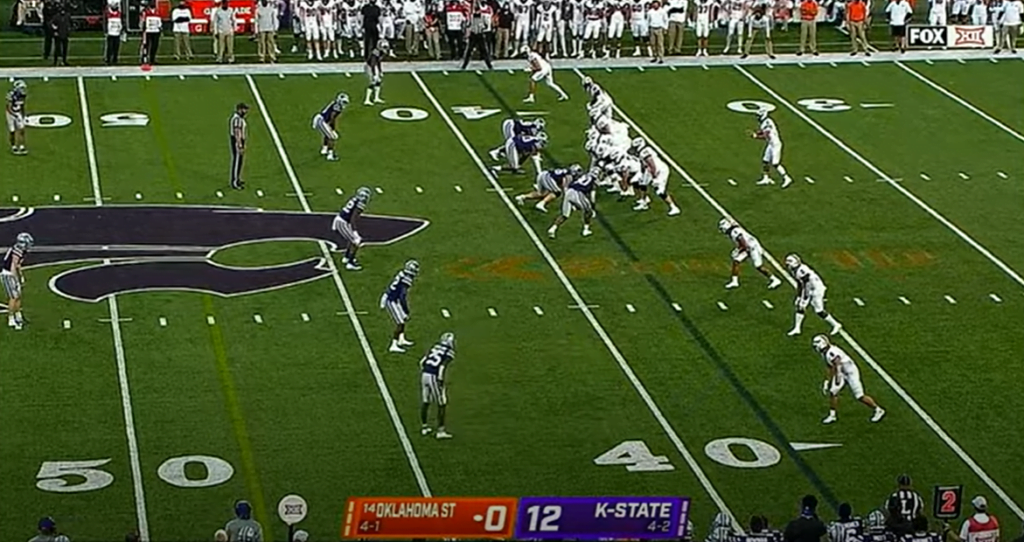
They had some success with this too, finding some openings in the K State pass coverage.
On the other hand, one thing we didn’t see one thing from Oklahoma State which we have seen a lot of the past two seasons against the Wildcats… the Diamond formation. They found success with it previously when attacking the KSU defense, but this year I don’t think the Cowboys lined up in it one time. We still saw a good chunk of 12 personnel formations but no Diamond.
The Pokes had one of their most balanced games of the season in terms of run/pass attempts against UT. However, OSU leaned heavily on the ground game against K State. The Cowboys had 40 carries for 148 yards (3.7 yards per attempt) compared to just 23 passing attempts from quarterback Spencer Sanders for 108 yards. The yards per carry number is low, but when you look at just Brown and Hubbard, the two combined for 141 yards on 21 attempts, good for 6.7 yards per rush.
Now, let’s get to more specifics from this gameplan.
Running Game
LD Brown and the zone scheme was a huge hit against K-State.
As a reminder, the terms Inside Zone and Outside Zone refer to blocking schemes that have the offensive linemen blocking specific gaps instead of a certain defender. If an O-lineman has a defender lined up in front of him, he blocks him. If he doesn’t have a defender lined up in front of him, then he steps toward the side the play is going and either helps double team block a defender or moves to the second level (think linebackers or safeties playing up near the line of scrimmage).
As I mentioned above, Brown had a solid day on the ground. His vision in the zone running game was excellent against K State. He had two of the only carries that went for over five yards in the first half, and both of them were on zone runs. We see one of those two plays below.
Brown also had another play similar to this in the second half where he got to show off a nice spin move as well, as you’ll see in the following clip.
The Toss Sweep
The Cowboys utilized the Toss Sweep several times on Saturday against KSU. The Toss Sweep consists of the quarterback taking the snap and then quickly pitching the ball to the running back who is headed toward the perimeter. The Pokes ran this play out of the bunch formation I showed earlier in this post, with two Cowboy Backs and a wide receiver to one side of the line of scrimmage.
OSU’s version of the Toss Sweep involves a blocking scheme sometimes referred to as “Truck“. Below you’ll see a diagram of this play.
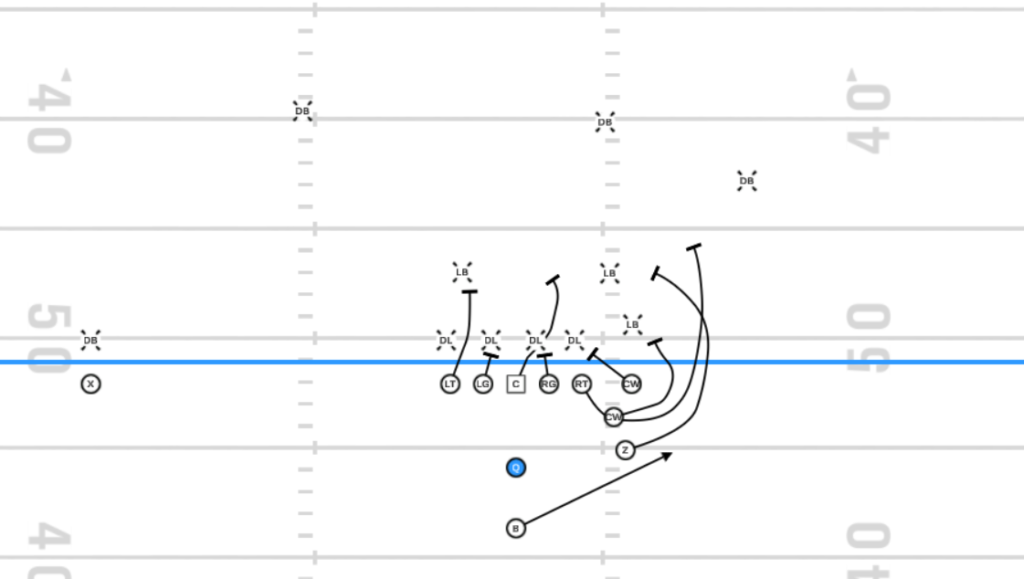
Truck consists of one bunch receiver blocking down on the defensive end (Woods), one blocking the defender over him (Carter on the linebacker) and the third receiver (Presley) “arc” blocking around to the second or third level as a lead blocker for the running back. In addition, the playside tackle will pull and also lead block for the running back. The rest of the line is basically blocking a zone scheme. See the video below.
I really like this play as it gets OSU’s talented running backs out in space with several lead blockers. Also, if the defense shifts a linebacker to the strongside, as the Wildcats did here, it makes it an easy block for the player in Woods’ position.
Overall, we primarily saw the Cowboys utilize zone schemes in this one, there were a couple of gap scheme running plays, but Dunn mainly stuck with zone.
Passing Attack
Since there were only 14 completions for 108 yards, there weren’t a lot of major positive takeaways from the passing game. We saw some of the OSU go-to passing concepts, like the Shallow concept.
The basic premise behind the shallow concept is to place the hole player aligned over the dig runner in a vertical stretch. The outside receivers will run either a go (versus press) or 6 step speed cut out route that ends up at a depth of 12 yards. It looks like the QB eyes pre-snap leverage to decide whether to throw the out. If the out isn’t there he will progress to the dig/shallow concept. The shallow will usually come from the boundary. The back will run a swing to the side the shallow came from.
[wesleyrossfootball.wordpress.com]
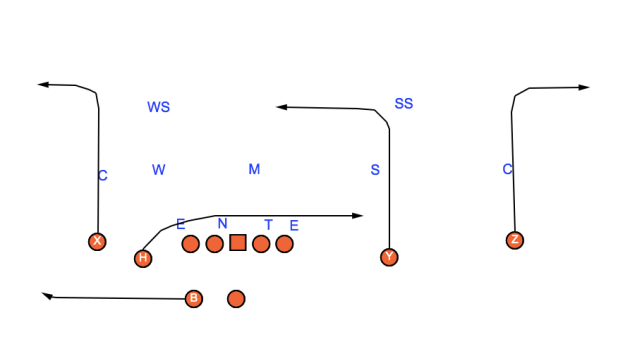
With the Wildcats playing off coverage on Cowboy receiver Dillon Stoner, Sanders knows he will most likely be open on the out route and fires a nice ball to the outside. See the clip below.
Stoner finished the game as the leading receiver for the Pokes with 62 yards, but aside from the play shown above and another deep pass over the middle early on, most of Stoner’s receptions were for short gains.
The second leading receiver, and the only other receiver to catch more than one pass, was Landon Wolf. Sanders was able to find Wolf on underneath routes on several occasions. A couple examples shown in the next two videos.
After the Texas game, where we saw some interesting route concepts and really cool play designs, the passing game seemed to be less creative against K-State. Additionally, Sanders didn’t have his best throwing day, but he didn’t have any turnovers either.
Hopefully the offense can get healed up and be firing on all cylinders for Bedlam in two weeks.

-
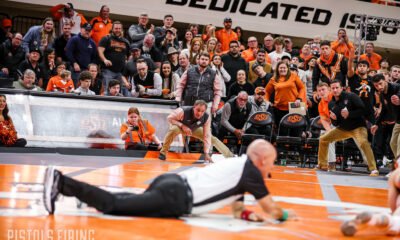
 Wrestling4 days ago
Wrestling4 days ago‘Made it Work’: How John Smith’s Coaching Career Began at 26 Alongside Teammate Kenny Monday
-
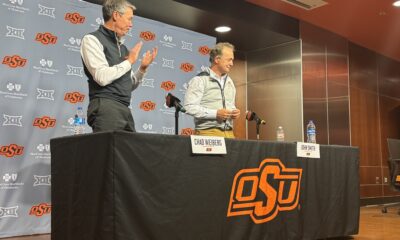
 Wrestling2 days ago
Wrestling2 days agoThe Top 5 Quotes from John Smith’s Retirement News Conference
-
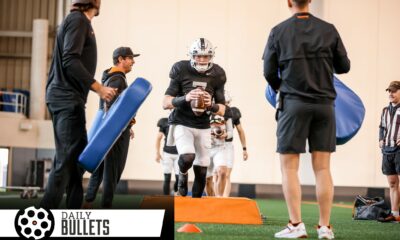
 Daily Bullets5 days ago
Daily Bullets5 days agoDaily Bullets (Apr. 13): Caveat to OSU Being a Top-Ten Team
-
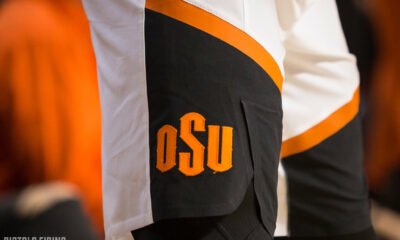
 Hoops3 days ago
Hoops3 days agoReport: Former Arkansas Guard Davonte Davis to Visit Oklahoma State






